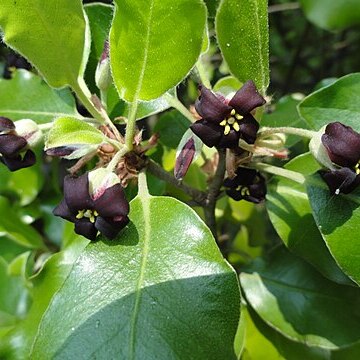Shrub 2.5–5 (–7) m high, branches spreading. Leaves alternate, frequently crowded at the tips of the branchlets; lamina oblong-elliptic to obovate or occasionally oblanceolate, 40–120 mm long, 20–40 mm wide, white-to buff-tomentose when young, soon glabrous above but remaining densely appressed-white-tomentose beneath, coriaceous; margin entire, unthickened, flat or revolute, undulate; petiole 8–22 mm long, white to grey-hairy; leaves of some cultivars are variegated. Inflorescences terminal on long leading or short axillary shoots, 2–10-flowered umbels, fascicled. Flowers generally appearing hermaphrodite but ?may sometimes be functionally unisexual, urceolate; pedicels 6–14 mm long. Sepals linear, 5–11 mm long, pale. Petals oblanceolate-linear to oblong-linear, 10–18 mm long, 2–4 mm wide, united for a little more than half their length from base, free in apical third and then spreading rapidly becoming strongly reflexed, dark red to purple. Stamens 4.5–9.0 mm long. Ovary white-tomentose. Capsules trigonous, oblate to obovoid, 3-or rarely 2-valved, apiculate, 11–17 (–20) mm long, 9–15 mm diam., white-tomentose, glabrate, rugose. Seeds 9–17, black, irregular to round.
More
Shrub with spreading branches up to c. 4 m. tall; bark dark brown; branchlets, lvs below, petioles and peduncles densely clad in white to buff tomentum. Lamina coriac., 7·5-12.5 × 2.5-5·5 cm., on petiole ± 1·5-2 cm. long; elliptic-to obovate-oblong, obtuse to acute, rather abruptly narrowed to petiole. Umbels terminal, 3-10-fld; peduncles c. 1·5 cm. long. Sepals narrow-ovate to subulate, 5-7 mm. long; petals narrow-oblong, c. 1 cm. long, dark red. Capsules broad-ovoid, 3-valved, c. 1·5 cm. long, pubescent, on slender pedicels.

